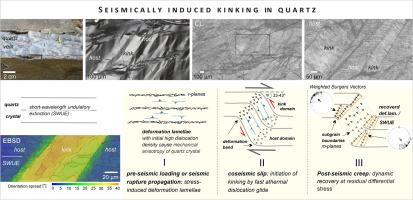地震引起的石英扭结
IF 4.8
1区 地球科学
Q1 GEOCHEMISTRY & GEOPHYSICS
引用次数: 0
摘要
在Schobergruppe(奥阿尔卑斯结晶杂岩,东阿尔卑斯)中,在一条出土的含假水杨酸(即古地震)断层(1-1.5 m)附近,变形的石英脉含有强烈的扭结石英颗粒。扭结带的单斜对称性与断层的右向滑动感一致。阴极发光图像显示,在电子背散射取向对比中,颗粒内、亚平面、片层的密度非常高,并伴有纳米尺度的流体相关孔隙。基于亚晶界(取向偏差1 ~ 9°)的振荡取向变化,这些片层(平行于菱形平面,间距4 ~ 10 μ m)被识别为短波波动消光微结构(SWUE)。透射电子显微镜显示了高程度的恢复(低位错密度)横跨SWUE。只有平行于脉界的SWUE晶粒才会发生扭结。基于详细的显微结构和晶体学分析,我们推断出以下与地震旋回有关的扭结演化历史:(1)在地震破裂传播之前或与地震破裂传播相关的高差应力下形成的变形片层。变形片内最初的高位错密度提供了石英的力学各向异性,这是(II)随后的同震引发扭结所必需的。片层作为一个几何过滤器,只允许平行于片层的位错发生r <; a>;滑移。这些非热位错能够快速滑动相对较大的距离,然后在同震事件中堆积并开始扭结。位错的逐渐累积导致了变形带的累积,最终形成了主畴与扭结畴之间的错取向角。(III)震后变形过程中的残余应力导致位错动态重排为亚平行亚晶界,这是现今扭扭带边界区的特征。我们认为石英中的扭结可能表明同震变形,并且是高应变速率下早期应变调节的重要机制。本文章由计算机程序翻译,如有差异,请以英文原文为准。

Seismically induced kinking in quartz
Deformed quartz veins next (1–1.5 m) to an exhumed pseudotachylyte-bearing (i.e. anciently seismic) fault within the Schobergruppe (Austroalpine Crystalline Complex, Eastern Alps) contain intensely kinked quartz grains. The monoclinic symmetry of kink bands is consistent with the dextral slip sense of the fault. Cathodoluminescence images show a very high density of intragranular, sub-planar, lamellae accompanied by nanometre-scale fluid-related porosity visible in electron backscatter orientation contrast. Based on the oscillating orientation variation across subgrain boundaries (misorientation angle 1–9°) these lamellae (oriented (sub)parallel to a rhomb plane and spaced 4–10 µm apart) are identified as short-wavelength undulatory extinction microstructures (SWUE). Transmission electron microscopy reveals a high degree of recovery (low dislocation density) across the SWUE. Only grains with SWUE oriented parallel to the vein boundary are kinked. Based on detailed microstructural and crystallographic analysis, we infer the following history of kinking evolution related to the seismic cycle: (I) Deformation lamellae formed at high differential stresses preceding, or associated with, seismic rupture propagation. The initial high dislocation density within deformation lamellae provided the mechanical anisotropy in quartz required for (II) the subsequent coseismic initiation of kinking. The lamellae acted as a geometric filter that only allowed r < a> slip of dislocations parallel to the lamellae. These athermal dislocations were able to glide fast over a relatively large distance before piling up and initiating kinking during the coseismic event. Progressive build-up of dislocations resulted in deformation bands which accumulated the final misorientation angle between host domain and kink domain. (III) Residual stress during post-seismic deformation induced dynamic re-arrangement of dislocations into sub-parallel subgrain boundaries which now characterize the kink band boundary region. We suggest that kinking in quartz potentially indicates coseismic deformation and is an important mechanism for incipient strain accommodation during high strain rates.
求助全文
通过发布文献求助,成功后即可免费获取论文全文。
去求助
来源期刊

Earth and Planetary Science Letters
地学-地球化学与地球物理
CiteScore
10.30
自引率
5.70%
发文量
475
审稿时长
2.8 months
期刊介绍:
Earth and Planetary Science Letters (EPSL) is a leading journal for researchers across the entire Earth and planetary sciences community. It publishes concise, exciting, high-impact articles ("Letters") of broad interest. Its focus is on physical and chemical processes, the evolution and general properties of the Earth and planets - from their deep interiors to their atmospheres. EPSL also includes a Frontiers section, featuring invited high-profile synthesis articles by leading experts on timely topics to bring cutting-edge research to the wider community.
 求助内容:
求助内容: 应助结果提醒方式:
应助结果提醒方式:


